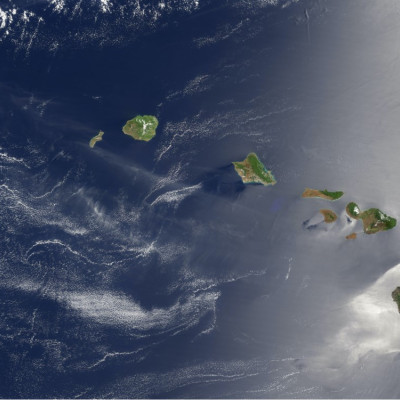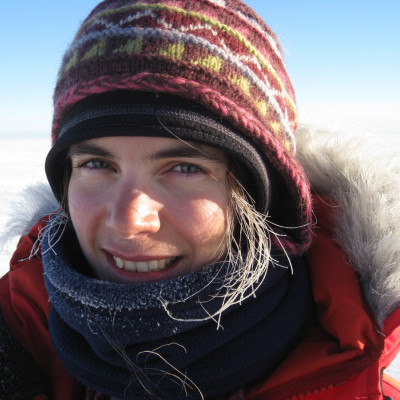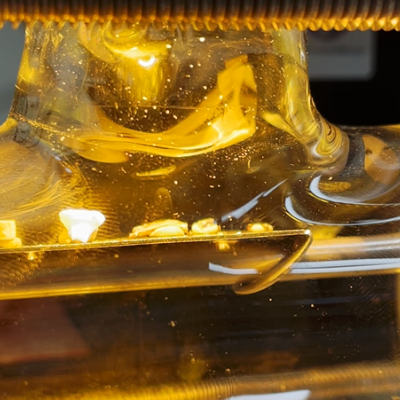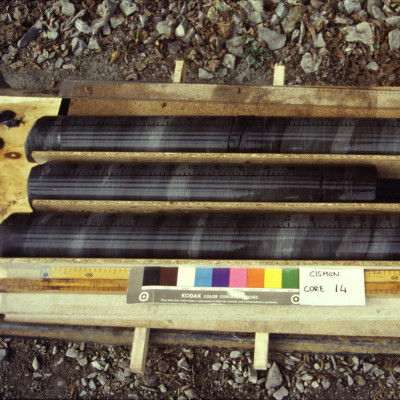News
Stay up-to-date with what's happening in EOAS
New Numerical Model Illuminates Mercury's Early Tectonic, Volcanic, and Magnetic Field History
Dr. Georgia Peterson, Dr. Mark Jellinek, and Dr. Catherine Johnson
Understanding a planet’s thermal history—how it cools over time—helps scientists determine how its surface, interior and atmosphere evolved. Mercury is among the most enigmatic of the inner solar system planets in terms of its evolution. The Mariner 10 and MESSENGER missions have revealed that the planet has undergone substantial contraction, that it has today and had in the past a global magnetic field, and that it had extensive volcanic activity early in its history. At about one third the radius of Earth, how such a small planet came to be characterized by processes most scientists ascribe to larger planets like Earth has been a mystery.
Mercury is notoriously difficult to observe from Earth, and hard for spacecraft to reach, due to its fast orbital speed and proximity to the Sun. Despite this, some major milestones in the planet’s history are known – revealed by data collected by the only two spacecraft to have visited the planet. The reverse faults that dominate Mercury’s surface are evidence for the first milestone, known since the Mariner 10 mission in the 1970s. These faults indicate that Mercury began to radially contract around 3.9 billion years ago, shrinking due to interior secular cooling, leaving the entire planet marred by giant, step-like scarps. The MESSENGER mission from 2008 to 2015 confirmed these observations and added two new major discoveries to them. Images of the surface from cameras onboard the MESSENGER spacecraft revealed evidence for a second milestone: planet-wide volcanic activity, voluminous enough to have formed a 15-60 km-thick crust that was later deformed as the planet contracted. The magnetic field recorded in this crust is evidence for the third of these milestones: it indicates that Mercury’s core produced an electromagnetic dynamo (i.e., a global magnetic field) from roughly 4 to 3.5 billion years ago. For all three of these events—volcanism, global contraction and an active dynamo—to have occurred, Mercury had to have cooled immensely in the earliest stages of its life as a planet. Until now, no thermal evolution model incorporates this early strong cooling.
In a new approach, PhD Candidate Georgia Peterson and Dr’s Mark Jellinek and Catherine Johnson have created a new set of thermal models for Mercury. Peterson posits that the early ‘volcanic resurfacing’ acted as a major pathway for heat to travel from the interior of the planet to the crust and then out into space, providing the large early cooling event missing in other models. Incorporating this cooling event into their model accounts for the major milestones in the planet’s history: Mercury’s early cooling both sustained its core dynamo by driving convection in the planet’s molten interior, and accounts for the planet’s crustal contraction. The outputs of their model not only predict the total amount of radial contraction, but match the geological evidence that this contraction occurred more rapidly early in Mercury’s history than it does today.
Along with Mercury’s extensive volcanic past, Peterson’s model also takes into account finer details, such as how mantle concentrations of H2O and heat-producing radioactive elements change during volcanic resurfacing, a new approach to calculate the amount of global contraction, and a more rigorous method of determining dynamo generation in a planetary core. Incorporating these new aspects into her modeling approach has had impressive results; 36% of her models can account for Mercury’s early contraction and dynamo milestones, compared to only 2% when the approach in previous studies is used. Their work, recently published in the October issue of Science Advances, opens the door to future studies on Mercury’s modern-day core dynamo and could help reconcile tectonics and dynamo generation on planets like Mars, Venus and Earth that also underwent early global volcanic resurfacing.
Thallium isotopic compositions reveal recycled materials on the Kea side of the Hawaiian mantle plume
Nicole Williamson, Dominique Weis
The deep, ‘ambient’ pacific mantle sampled by the Kea side of the Hawaiian plume, which was thought to be relatively chemically homogeneous, contains chemical heterogeneities, according to a new UBC EOAS research published in Geochemistry, Geophysics, Geosystems.
The Hawaiian Island volcanoes record 6 Ma (mega annum; millions of years) of potentially deep mantle chemistry and form two parallel volcanic chains that are geochemically unique, named Loa and Kea. Volcanoes from the Loa trend have more “enriched” isotopic compositions, indicative of the presence of recycled surface materials in their source, whereas volcanoes from the Kea trend tend to have average deep Pacific mantle compositions.
To explore the source and origin of mantle heterogeneities in Hawaiian lavas, lead researcher Nicole Williamson (Ph.D. Candidate, Pacific Centre for Isotopic & Geochemical Research) and her co-authors Dominique Weis and Julie Prytulak (Durham University) measured thallium (TI) isotopic composition in Hawaiian basalt samples. Tl isotopes (205Tl and 203Tl) are unequally distributed across Earth's chemical reservoirs and can show large concentration contrasts, for example between pelagic sediments (>>100 ng/g) and the Earth's mantle (<1 ng/g).
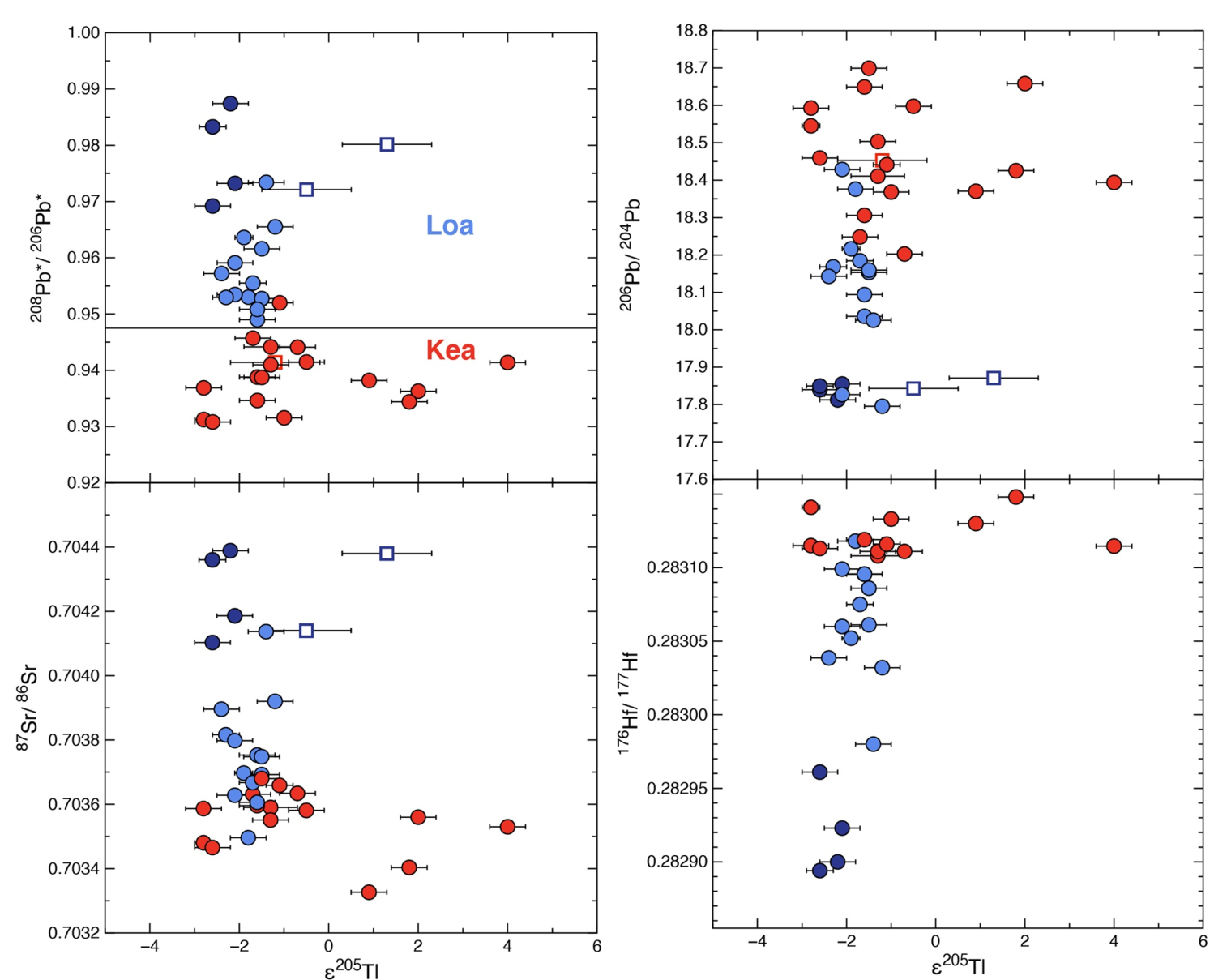
Thallium isotopic compositions in Hawaiian lavas compared to radiogenic isotopes from Williamson et al, 2021.
The scientists found that among other indicators, the heavier Tl isotopic compositions measured in some volcanoes of the Kea geochemical trend might co-vary with oxygen isotopes, suggesting that their Tl compositions could also result from the presence of recycled surface materials in their source. “The Loa side of the Hawaiian plume typically erupts more chemically heterogeneous lavas, but in the case of thallium isotopes, it’s the Kea side that is more diverse in composition,” says Williamson.
The study shows that the mantle source of both the Loa and Kea geochemical trends likely contains materials recycled through the mantle, which is significant because thus far the Kea volcanoes have shown fairly uniform isotopic compositions representative of the average, deep Pacific mantle.
Meet Anaïs Orsi - Climate Scientist
Anaïs Orsi is an Assistant Professor in the Department of Earth, Ocean and Atmospheric Sciences (EOAS) at UBC. Her research focuses on polar climate variability using tracers found in ice cores. Today, the Arctic is the region that is warming the fastest on Earth. Anais’s work is to provide context to the current trend by reconstructing the climate of the recent past (several thousand years) using indicators found in ice cores. These indicators can be the thickness of an annual layer of snow, the presence of an ice lens indicating melting, the isotopic composition of the water that snow is composed of, or simply the temperature inside the ice sheet. All of these indicators give a complementary information of what the past climate might have looked like, and help put the recent trends in context. This work has led her to repeatedly visit polar regions, in Greenland and Antarctica, in the search for clues of past climates.
Prior to joining UBC, Anaïs completed her PhD at the University of California San Diego, and subsequently worked as a research scientist at the LSCE (Climate and Environmental Science Laboratory) in France. Her work has been distinguished by several prizes, including the International Rising Talent of the L’Oreal-UNESCO foundation for women in Science.
Meet Randy Smallwood: EOAS alumni, Geological Engineer & CEO of Wheaton Precious Metals
Randy Smallwood holds a geological engineering degree from the University of British Columbia and is one of the founding members of Wheaton Precious Metals. In 2007, he joined Wheaton full time as EVP of Corporate Development, primarily focusing on growing the company through the evaluation and acquisition of streaming opportunities. In January 2010, he was appointed President, and in April 2011, he was appointed Wheaton's CEO.
Mr. Smallwood originally started as an exploration geologist with Wheaton River Minerals Ltd., and in 2001, was promoted to Director of Project Development, a role he held through the 2005 merger with Goldcorp (which has since merged with Newmont). Mr. Smallwood was an instrumental part of the team that built Wheaton River/Goldcorp into one of the largest and, more importantly, most profitable gold companies in the world. He is now focused on continuing to add to the impressive growth profile of Wheaton and leading the World Gold Council as its current chair.
Examining the chemistry of fossil mammals: stories from the past
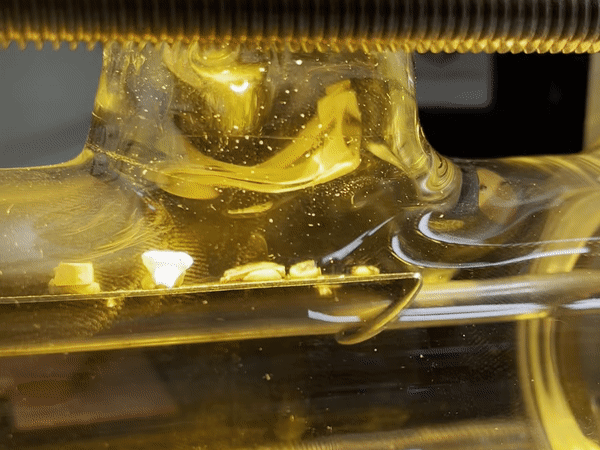
Kendra Chritz, Scott Blumenthal
Looking at the chemistry of ancient biological material (teeth, bones, soils) helps scientists to tell what past environments were like. But have you ever wondered what it may look like when sampling fossil mammals? Check out this animated image by EOAS geochemists & paleoecologists!
What you are looking at now is the inside of a custom-built laser ablation chamber for tiny in-situ sampling of enamel for carbon and oxygen isotopes. The laser spots are 200-500 microns (µm; 10-6 m) in diameter. The little puff of dust from the tooth enamel being shot contains CO2 that records the diet and environment of the organism while it was living.
This work is being done by Dr. Kendra Chritz, Assistant Professor at the Department of Earth, Ocean and Atmospheric Sciences, in collaboration with Dr. Scott Blumenthal, who is visiting UBC as a Research Associate currently, at the University of Oregon where this video was taken. "The goal of my research program is to understand the intimate ties between people and ecosystems across many different timescales using geochemistry, and how these environmental records provide the crucial data needed to understand the modern planet during the Anthropocene as we know it," says Dr. Chritz.
Inside the chamber, the scientists are sampling two very different sets of material. The first are middle-Holocene aged gerbil incisors extracted from a headdress made by a man 5,000 years ago. This is part of Dr. Chritz’s long-term collaborations and work on Kenyan prehistory and late Quaternary environmental change. The original excavation, as the New York Times reported, found that "most [people] were buried with ornamentation, including an infant who wore an ostrich eggshell bracelet. One man was buried with a headdress decorated with what researchers figured out were 400 carefully arranged gerbil teeth. He probably wore the headdress during life."
The second set of samples are teeth from multituberculates, our ancient mammalian ancestors, from the late Cretaceous. These particular rodent-sized mammals lived alongside dinosaurs. "We [Chritz and Blumenthal, along with PCIGR] are beginning a project with the Denver Museum of Natural History to explore how the diet and ecology of mammals changed following the K/Pg mass extinction, after which they evolved and created the mammal-driven world we live in today," says Dr. Chritz. This collaboration is building off of this project, also reported in the New York Times in 2019.
We also had a conversation with Dr. Chritz in our On Earth weekly podcast series: click here to learn more!
Volcanism drove rapid ocean deoxygenation during the time of the dinosaurs
Ocean deoxygenation during the Mesozoic Era was much more rapid than previous thought, with CO2 induced environmental warming creating ocean ‘dead zones’ over timescales of only tens of thousands of years.
The research from University of British Columbia (UBC) and University of Hong Kong (HKU) Earth scientists paints a new picture of severe ocean deoxygenation events in our planet’s geologic history.
“Physical drivers, in particular ocean warming linked to volcanic activity during the Cretaceous Period, played key roles in triggering and maintaining oceanic anoxia,” says lead researcher Dr. Kohen Bauer, who began the work while at UBC and completed the study with HKU’s Department of Earth Sciences.
“The same mechanisms are also critically important drivers of modern ocean deoxygenation and expanding marine dead zones. Today, in addition to volcanoes releasing CO2 into the atmosphere, humans are as well.”
Previous research tended to focus on the role ocean nutrient cycles played in causing so called ‘dead zones’—a process that would have driven ocean deoxygenation over much longer timescales of hundreds of thousands of years. However, it’s now clear that massive volcanism and its associated feedbacks was a more direct trigger for the rapid development of oceanic anoxia.
The research delved into the causes of Oceanic Anoxic Event 1a — an interval 120 million years ago when large swaths of Earth’s oceans became anoxic. Those conditions likely persisted for almost a million years, causing climate perturbations, and biotic turnover.
The scientists reconstructed the period’s environmental conditions using novel geochemical methods and ancient sediments deposited in both the paleo-Tethys and paleo-Pacific oceans.
“Mesozoic oceanic anoxic events are some of the most important analogs for unlocking lessons about warm-Earth climate states in the geological record,” says UBC’s Dr. Sean Crowe, author on the paper and Canada Research Chair in Geomicrobiology with UBC’s departments of Microbiology and Immunology, and Earth, Ocean and Atmospheric Sciences.
“These events provide enormous potential to help us better understand the sensitivity of the Earth system to perturbations in global biogeochemical cycles, marine biology, and climate on timescales relevant to humankind.”
The paper was published in the journal Geology.

